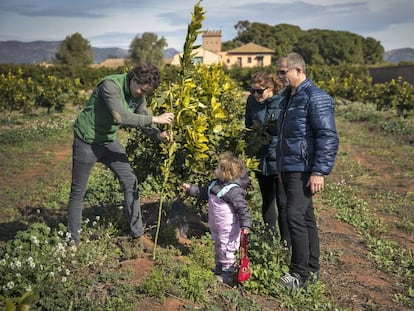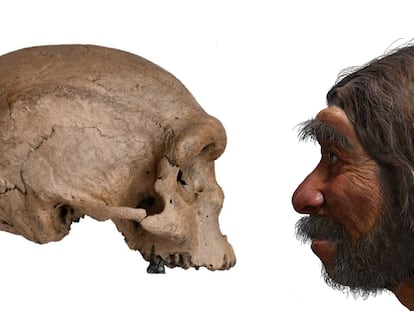The mutation that changed the history of mandarins
Biologist Manuel Talón has traced the origin of citrus fruits to the foothills of the Himalayas eight million years ago and mapped their evolution into modern edible varieties
Much of human history can be found inside a fruit store. For example, if a shopper asks for mandarins, they are using a word coined by Portuguese traders plying the South China Sea in the 16th century. For those Iberian explorers, mandarins were the bureaucrats of Imperial China, schooled under the teachings of Chinese philosopher Confucius. As they wore orange garments, the fruit of the same color was also given the same name. However, the history of mandarins began much earlier, according to biologist Manuel Talón, a member of an international team of experts who have shed light on the fascinating global voyage of this humble fruit.
Talón describes a rainforest where the ancestor of all citrus fruits originated, among the foothills of the Himalayas, in a region today split between China, India and Myanmar. Eight million years ago, a period of global cooling led to the displacement of those remote species. The ancestors of the lemon advanced towards the west and its descendants ended up as far away as what is today Spain, following the Muslim conquest of the Iberian peninsula. Those that migrated east were the descendants of mandarins, explains Talón, director of the Genomics Center at the Valencian Institute of Agricultural Research. In the Nanling Mountains of southern China, these proto-mandarins, which were then inedible, started to diversify.
In the world today, there are over nine million hectares of citrus orchards, an area roughly the size of Portugal
The new study has analyzed the genomes of 69 varieties of citrus and has uncovered the origin of an event that, in its own way, changed the course of human history. In many wild citrus fruits the pollen of a male parent plant, or its sperm, travels via bees to the flower of the mother plant. The result is a seed that gives rise to a new plant, with 50% of its genes from each of its progenitors. Around 1.6 million years ago, however, the mandarins of the Nanling Mountains underwent a natural change via a strange mutation that led to the emergence of the apomixis gene, a biological behavior whereby seeds only produce copies of the mother plant. “In humans, it would be as though an embryo was created by skin cells from the mother. It would be a clone,” says Talón.
Citrus fruits “are very promiscuous,” he notes. Three years ago, Talón and his team published a genealogical tree of citrus fruits in the scientific journal Nature, from their origin eight million years ago. Their research revealed another key event: Around 4,000 years ago, possibly on the banks of the Yangtze River, a pomelo tree (the mother species of the grapefruit) pollinated an ancestral mandarin tree, giving rise to edible varieties of mandarins. “Acidity was reduced, sugar levels were increased and the fruit grew larger in size: ancestral mandarins were only a little larger than olives,” Talón explains.
Apomixis, the biologist says, was a “dream” for the first agriculturalists, who were able to increase the numbers of their favorite trees by generating perfect copies, without risking the lottery of genetic coupling with a father plant. In the world today, there are over nine million hectares of citrus orchards, an area roughly the size of Portugal. And in all of the edible species – such as mandarins, oranges, grapefruit and lemons – apomixis is present, an exceptional characteristic in the plant kingdom, courtesy of that mutation 1.6 million years ago that passed from species to species and was later gratefully taken advantage of by early homesteaders. “Citrus fruits are an extreme matriarchy,” jokes Talón.
The genealogical tree displays a genuine orgy among species. The sweet orange is a daughter of a pomelo tree and a mandarin. The lemon is the offspring of a bitter orange mother and a citron, an aromatic fruit that was used in medieval medicine. “An edible citrus is a genetic mosaic, a blend of characteristics selected over millennia and brought together thanks to apomixis,” says Talón.
This new research, published in the specialist journal Nature Communications on July 26, has revealed the existence of a new species of wild mandarin in Japan’s Ryukyu Islands: Citrus ryukyuensis. Its ancestors would have arrived in the archipelago around five million years ago from the Nanling Mountains, the birthplace of all mandarins.
Talón’s team of researchers consists of seven Japanese and US scientists including Fred Gmitter, of the University of Florida. The US state is battling a plague of the deadliest citrus disease, Huanglongbing, or Yellow dragon disease, a bacteria of Asian origin that has decimated Florida’s citrus trees. Orange production in the United States plummeted by 72% between 2008 and 2018. Gmitter’s research group believes that Citrus ryukyuensis could contain the secret for creating citruses that are resistant to the lethal Huanglongbing.
Talón recalls the rest of the story of citrus fruits in Spain. The oranges that the Muslims brought to Al-Andalus (the Muslim-ruled area of the Iberian peninsula and parts of North Africa) in the 9th and 10th centuries were bitter, like those that can still be found today in the streets of Seville. “In the 15th and 16th centuries, sweet oranges arrived, already edible, probably on Portuguese boats,” the biologist notes. In 1805, British horticulturalist Abraham Hume introduced mandarins to Europe from the Chinese city of Guangzhou, the culmination of a journey that had begun eight million years earlier.
English version by Rob Train.
Tu suscripción se está usando en otro dispositivo
¿Quieres añadir otro usuario a tu suscripción?
Si continúas leyendo en este dispositivo, no se podrá leer en el otro.
FlechaTu suscripción se está usando en otro dispositivo y solo puedes acceder a EL PAÍS desde un dispositivo a la vez.
Si quieres compartir tu cuenta, cambia tu suscripción a la modalidad Premium, así podrás añadir otro usuario. Cada uno accederá con su propia cuenta de email, lo que os permitirá personalizar vuestra experiencia en EL PAÍS.
¿Tienes una suscripción de empresa? Accede aquí para contratar más cuentas.
En el caso de no saber quién está usando tu cuenta, te recomendamos cambiar tu contraseña aquí.
Si decides continuar compartiendo tu cuenta, este mensaje se mostrará en tu dispositivo y en el de la otra persona que está usando tu cuenta de forma indefinida, afectando a tu experiencia de lectura. Puedes consultar aquí los términos y condiciones de la suscripción digital.
More information
Archived In
Últimas noticias
Maduro pleads not guilty before the federal court in New York: ‘I am still the president of Venezuela’
A new test can detect Alzheimer’s from a finger prick
UN team enters Sudanese city of El Fasher after paramilitary massacre: ‘It’s like a ghost town’
A recipe for resistance: Indigenous peoples politicize their struggles from the kitchen
Most viewed
- Gilles Lipovetsky: ‘If you want to live better and fall in love, take Prozac, don’t look to philosophy’
- Alain Aspect, Nobel laureate in physics: ‘Einstein was so smart that he would have had to recognize quantum entanglement’
- Alvin Hellerstein, a 92-year-old judge appointed by Bill Clinton, to preside over Maduro’s trial in New York
- Maduro’s downfall puts China’s relationship with Venezuela to the test
- Why oil has been at the center of Venezuela-US conflicts for decades











































